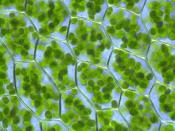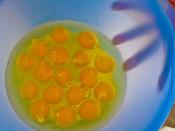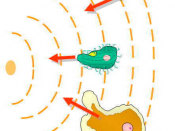About 2.5 billion years ago, oxygen began slowly to accumulate in the atmosphere, as a result of the photosynthetic activity of the cyanobacteria. Those prokaryotes that were able to use oxygen in ATP production gained a strong advantage, and so they began to prosper and increase. Some of these cells may have evolved into modern forms of aerobic bacteria. Other cells may have become symbionts with larger cells and evolved into mitochondria. As the amount of oxygen and other atmospheric gasses increased, they started blocking out deadly u.v. rays from the sun. The sun's rays made life outside of water nearly impossible. These changes made life on land possible and evolution occurred as prokaryotes gave rise to land living eukaryotes.
The microfossil record indicates that the first eukaryotes evolved at least 1.5 billion years ago. Eukaryotes are distinguished from prokaryotes by their larger size, the separation of nucleus from cytoplasm by a nuclear envelope, the association of DNA with histone proteins and its organization into a number off distinct chromosomes, and complex organelles, among which are chloroplasts and mitochondria.
Scientists believe that eukaryotic organisms such as the protists evolved from the prokaryotes. There are two main theories which describe how this transition may have occurred. The first is the endosymbiotic theory, or enosymbiosis, and the other is the autogenous theory, or autogenisis. These two theories are not mutually exclusive, meaning one or the other could account for different parts of eukaryotic cells. The endosymbiotic theory states that the formation of eukaryotic cells were symbiotic associations of prokaryotic cells living inside larger prokaryotes. The endosymbiotic hypothesis accounts for the presence in eukaryotic cells of complex organelles not found in the far simpler prokaryotes. Many modern organisms contain intracellular symbiotic bacteria, cyanobacteria, or photosynthetic protists, indicating that such associations are not difficult...



Hmmm.....!!??
Great opening...but you abruptly ended the paper without going into detail about the "possibilities"...
The paper didn't really support the title...
But it did provide the bud for a research project...
Average Job...
3 out of 4 people found this comment useful.